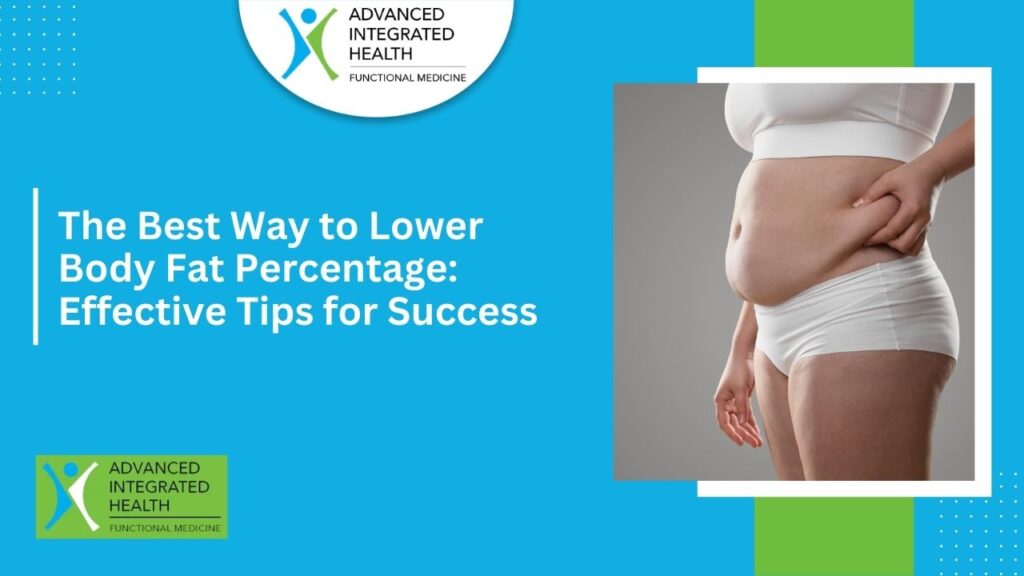Understanding how to effectively lower body fat percentage is crucial for achieving optimal wellness and enhancing overall quality of life. While many people embark on weight loss journeys, the focus should be on sustainable fat loss that preserves muscle mass rather than just shedding pounds.
Let’s explore science-backed strategies in this quick guide that also offers practical tips to foster lasting results.
Understanding Body Fat: The Foundation of Weight Loss
The Role of Body Fat
Body fat plays a crucial role in our overall health, but maintaining the right balance is key to optimal wellness. Essential body fat is vital for survival, protecting our organs, regulating body temperature, and supporting hormone production. However, excess body fat, particularly visceral fat around the organs and belly fat beneath the skin, can lead to serious health complications.
Types of Body Fat
Understanding the different types of fat in your body is crucial when working on losing body fat. While essential body fat is necessary for survival, comprising about 3% for men and 12% for women, stored fat consists of two main types:
- Subcutaneous Fat: Lies just beneath the skin and is what you can pinch.
- Visceral Fat: Surrounds your organs and poses greater health risks.
Metabolism and Fat Storage
Your metabolism plays a significant role in how your body processes and stores fat. A slower metabolism can make it more challenging to burn fat, but various factors influence your metabolic rate, including muscle mass, activity level, and even stress levels. Building muscle through weight training can help boost your metabolism and burn more calories, even at rest.
Nutritional Responses and Fat Loss
The path to reducing body fat percentage requires understanding how your body responds to different foods and exercise. Good fats, found in sources like olive oil, can actually support weight loss, while trans fats contribute to weight gain and health problems. Moreover, maintaining stable blood sugar levels through proper carbohydrate intake helps prevent excess glucose from being stored as fat.
The Science Behind Losing Body Fat Effectively
Losing body fat involves a complex interplay between calorie intake, energy expenditure, and hormonal balance. To effectively burn fat, your body needs to be in a caloric deficit, meaning you consume fewer calories than you burn. However, this deficit should be moderate – typically 500-750 calories per day – to prevent muscle loss and maintain a healthy metabolism.
Factors Influencing Fat Burning
Understanding how your body burns fat is crucial for successful weight loss. Various factors influence this process, including:
- Insulin Resistance: High insulin levels can make it harder to burn fat, emphasizing the importance of managing blood sugar.
- Stress Hormones: Stress can impact fat burning negatively.
- Gut Bacteria: An emerging area of research, the gut microbiome can influence how your body processes nutrients and stores fat.
Exercise and Metabolic Rate
Your body’s ability to burn calories faster improves with regular exercise, particularly through:
- High-Intensity Interval Training (HIIT): This method burns calories during and after workouts through the “afterburn effect.”
- Strength Training: Building muscle through weight training helps maintain a higher resting metabolism, as muscle tissue burns more calories than fat tissue.
Importance of Protein
The role of protein in this process cannot be overlooked. Adequate protein intake helps preserve muscle mass during weight loss, supports fat burning, and keeps you feeling fuller longer. Combined with smart carbohydrate intake and good fats, protein helps create the optimal hormonal environment for fat loss while providing the energy needed for effective workouts.
Best Ways to Lower Body Fat Percentage: A Comprehensive Approach
Strategic Exercise and Nutrition
The best way to lower body fat percentage combines strategic exercise, proper nutrition, and lifestyle modifications. Unlike focusing solely on weight loss, which can lead to muscle loss, the goal is maintaining or building muscle mass while reducing fat stores. This approach ensures long-term success and a healthier body composition.
Understanding Body Composition Metrics
Understanding the difference between body mass index (BMI) and body fat percentage is crucial. While BMI calculates weight in relation to height, it doesn’t account for muscle mass or fat distribution. For example, an athlete with significant muscle mass might have a high BMI but a healthy fat percentage. This is why tracking body fat percentage provides a more accurate picture of your fitness progress.
Measuring Body Fat Percentage
Measuring your body fat percentage accurately helps guide your fat loss journey. While various methods are available, from simple skinfold calipers to sophisticated DXA scans, consistency in measurement methods is key. For most people, taking measurements every 4-6 weeks provides enough data to track progress without becoming obsessive about numbers.
Setting Realistic Goals
Setting realistic goals is essential when working to reduce body fat. A healthy rate of fat loss is typically 0.5-1% of body fat per month, though this can vary based on starting point and individual factors. Overweight women and men might see faster initial progress, while those already lean may need to be more patient. Working with a personal trainer can help establish appropriate targets and strategies for your specific situation.
Nutrition Strategies for Reducing Body Fat
Effective Nutrition Planning
Creating an effective nutrition plan is fundamental to reducing body fat. The key lies in managing calorie intake while choosing foods that support fat loss and preserve muscle mass. A moderate caloric deficit of 500 calories daily can lead to sustainable fat loss without triggering a slower metabolism or excessive hunger.
Protein Intake
Protein plays a crucial role in your body’s ability to burn fat and maintain muscle. Aim for 1.6-2.2 grams of protein per kilogram of body weight, emphasizing lean sources like chicken, fish, and plant-based options. This higher protein intake helps preserve muscle mass during weight loss and increases satiety, making it easier to stick to your food intake goals.
Smart Carbohydrate Choices
Smart carbohydrate intake focuses on timing and quality rather than complete elimination. Whole grains, vegetables, and fruits provide necessary energy while helping maintain stable blood sugar levels. This approach prevents insulin resistance and the storage of excess glucose as fat. White bread and refined carbs should be limited, as they can spike blood sugar and promote fat storage.
Healthy Fats
Good fats are essential for hormone production and fat-soluble vitamin absorption. Sources like olive oil, nuts, and avocados support weight loss by providing sustained energy and reducing inflammation. However, trans fats should be avoided as they contribute to weight gain and health problems. Remember that even healthy fats are calorie-dense, so portion control remains important.
Exercise Methods to Burn Fat Effectively
High-Intensity Interval Training (HIIT)
High-intensity interval training (HIIT) stands out as one of the most efficient ways to burn fat and transform your body composition. This training method alternates between short bursts of intense exercise and brief recovery periods, helping you burn more calories during and after your workout. The afterburn effect can last for hours, making HIIT particularly effective for those looking to burn fat while preserving muscle mass.
Weight Training
Weight training is equally crucial in your journey to lose fat. Lifting weights and targeting different muscle groups stimulates muscle growth and increases your metabolic rate. The more muscle mass you have, the more calories your body burns at rest. Focus on compound exercises that work for multiple muscle groups simultaneously, such as squats, deadlifts, and push-ups, to maximize calorie burn and improve overall strength.
Resistance Bands
Resistance bands offer a versatile alternative to traditional weight training, especially for beginners or those working at home. These bands can help in building muscle while burning calories, and they’re excellent for targeting specific muscle groups. Resistance bands can create an effective full-body workout that supports fat loss goals when combined with bodyweight exercises.
Structured Strength Training
Strength training should be structured to burn more calories while building lean muscle. This means incorporating supersets, circuit training, and minimal rest periods between exercises. Working with a personal trainer can help ensure proper form and progressive overload, which are essential for continued progress and preventing plateaus in your fat loss journey.
Lifestyle Factors Affecting Body Fat Percentage
Importance of Sleep
Getting enough sleep plays a crucial role in fat loss that many people overlook. Poor sleep can disrupt hormones that regulate hunger and metabolism, making it harder to lose weight and easier to gain fat. Aim for 7-9 hours of quality sleep per night to support your body’s fat-burning processes and maintain optimal energy levels for exercise.
Stress Management
Managing stress levels is equally important in your quest to reduce body fat. High stress triggers the release of cortisol, a hormone that can promote belly fat storage and make it harder to burn fat effectively. Incorporate stress-management techniques like meditation, yoga, or deep breathing exercises into your daily routine. These practices not only help control stress but can also improve sleep quality and overall well-being.
Gut Health
Recent research has focused on the role of gut bacteria in weight management. A healthy gut microbiome can influence how your body processes nutrients and stores fat. To support beneficial gut bacteria, focus on consuming fiber-rich foods and probiotic sources. Avoid processed foods and excessive antibiotics, which can disrupt your gut’s bacterial balance.
Intermittent Fasting
Intermittent fasting has emerged as a powerful tool for fat loss, offering benefits beyond simple calorie restriction. This approach can help regulate blood sugar levels, improve insulin sensitivity, and enhance fat burning. However, it’s essential to implement fasting gradually and choose an approach that fits your lifestyle and preferences. Common methods include the 16/8 protocol or alternate-day fasting, but consult with health professionals before starting any fasting regimen.
Common Mistakes and How to Avoid Them
Misunderstanding Body Composition
One of the most frequent obstacles in losing body fat is misunderstanding why some people struggle to lose fat despite their best efforts. A common mistake is focusing solely on the number on the scale rather than body composition. Weight loss doesn’t always equal fat loss – you might be losing valuable muscle mass instead of fat, leading to a slower metabolism and making it harder to maintain long-term results.
Metabolism Awareness
Understanding your metabolism is crucial for successful fat loss. Many people dramatically cut calories, leading to a slower metabolism as the body adapts to conserve energy. This adaptation can make it increasingly difficult to burn fat effectively. Instead of severe calorie restriction, focus on creating a moderate caloric deficit while maintaining adequate protein intake to preserve muscle mass and keep your metabolism running efficiently.
Preventing Muscle Loss
Preventing muscle loss during fat loss requires a strategic approach. Simply eating fewer calories without proper nutrition and exercise can lead to losing fat and muscle. This is particularly important because muscle tissue burns more calories than fat tissue, even at rest. Ensure you consume enough protein and incorporate regular strength training to maintain muscle mass while burning fat.
Avoiding Quick-Fix Solutions
Quick-fix solutions and fad diets often promise rapid results but can be counterproductive for long-term success. These approaches typically lead to rapid weight loss followed by equally rapid weight gain, creating a cycle that can damage your metabolism and make future fat loss efforts more challenging. Instead, focus on sustainable habits that you can maintain over time.
Wrap-Up
While understanding the principles of fat loss is crucial, implementing them effectively requires expertise and support. Taking control of your health journey means working with experts who can guide you through the complexities of fat loss and body transformation.
Ready to transform your body and health? Contact Advanced Integrated Health today to begin your journey toward optimal wellness. Our team is ready to help you achieve your goals through evidence-based strategies and personalized support. Call us to schedule your initial consultation and take the first step toward a healthier, leaner you.
Citations
- Villines, Z. (2023, November 27). Body fat percentage charts for men and women. https://www.medicalnewstoday.com/articles/body-fat-percentage-chart
- Oudat, Q., & Okour, A. (2025). The role of probiotics in modulating gut microbiota and metabolic health for weight management: a mini-review. Deleted Journal, 70(1), 5. https://doi.org/10.3390/amh70010005
- Cronkleton, E. (2025, January 10). How to lose fat without losing muscle. Healthline. https://www.healthline.com/health/exercise-fitness/how-to-lose-fat-without-losing-muscle

Dr. Bob was born and raised in Florham Park, New Jersey.
He loved the philosophy of vitalism, which teaches about the incredible, innate intelligence of our bodies and its power to self-heal when given the opportunity.



